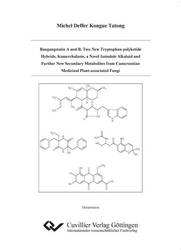| Fachbereiche | |
|---|---|
| Buchreihen (96) |
1378
|
| Nachhaltigkeit |
3
|
| Gesundheitswesen |
1
|
| Geisteswissenschaften |
2364
|
| Naturwissenschaften |
5406
|
| Mathematik | 229 |
| Informatik | 319 |
| Physik | 980 |
| Chemie | 1363 |
| Geowissenschaften | 131 |
| Humanmedizin | 243 |
| Zahn-, Mund- und Kieferheilkunde | 10 |
| Veterinärmedizin | 108 |
| Pharmazie | 147 |
| Biologie | 835 |
| Biochemie, Molekularbiologie, Gentechnologie | 121 |
| Biophysik | 25 |
| Ernährungs- und Haushaltswissenschaften | 45 |
| Land- und Agrarwissenschaften | 1004 |
| Forstwissenschaften | 201 |
| Gartenbauwissenschaft | 20 |
| Umweltforschung, Ökologie und Landespflege | 148 |
| Ingenieurwissenschaften |
1793
|
| Allgemein |
98
|
|
Leitlinien Unfallchirurgie
5. Auflage bestellen |
|
Erweiterte Suche
Bangangstatin A and B, Two New Tryptophan-polyketide Hybrids, Kamerchalasin, a Novel Isoindole Alkaloid and Further New Secondary Metabolites from Cameroonian Medicinal Plant-associated Fungi
Michel Deffer Kongue Tatong (Autor)Vorschau
Inhaltsverzeichnis, PDF (68 KB)
Leseprobe, PDF (130 KB)
For centuries medicine and natural products have been closely linked through the use of traditional medicines. Plants, insects, microorganisms and marine organisms exhibit complex interactions with the environment and produce small molecules (natural products) useful for their survival. Natural products have served mankind as the source of drugs, and higher plants provided most of these therapeutic agents. Today, natural products (their derivatives and analogs) still represent over 50% of all drugs in clinical use, with higher plant-derived natural products representing ca. 25% of the total. The World Health Organization estimates that 80% of the people in developing countries of the world rely on traditional medicine for their primary health care, and about 85% of traditional medicine involves the use of plant extracts. This means that about 3.5 to 4 billion people in the world rely on plants as sources of drugs. Clinical, pharmacological, and chemical studies of these traditional medicines, which were derived predominantly from plants, were the basis of most early medicines such as the famous analgesic morphine (1) isolated from opium, the latex produced by cutting the seed pods of poppy, Papaver somniferum and the world-famous aspirin (2) with analgesic, anti-inflammatory, and antipyretic properties. The latter is a derivative of salicylic acid, which was first isolated from willow trees Salix sp. And has been modified to improve the activity and reduce side-effects. Aspirin (2) is one of the best-known examples for the prosperous interaction of natural and synthetic products chemistry.
| ISBN-13 (Printausgabe) | 9783954045457 |
| ISBN-13 (E-Book) | 9783736945456 |
| Buchendformat | A5 |
| Sprache | Englisch |
| Seitenanzahl | 340 |
| Umschlagkaschierung | matt |
| Auflage | 1. Aufl. |
| Erscheinungsort | Göttingen |
| Promotionsort | Göttingen |
| Erscheinungsdatum | 04.11.2013 |
| Allgemeine Einordnung | Dissertation |
| Fachbereiche |
Chemie
|








